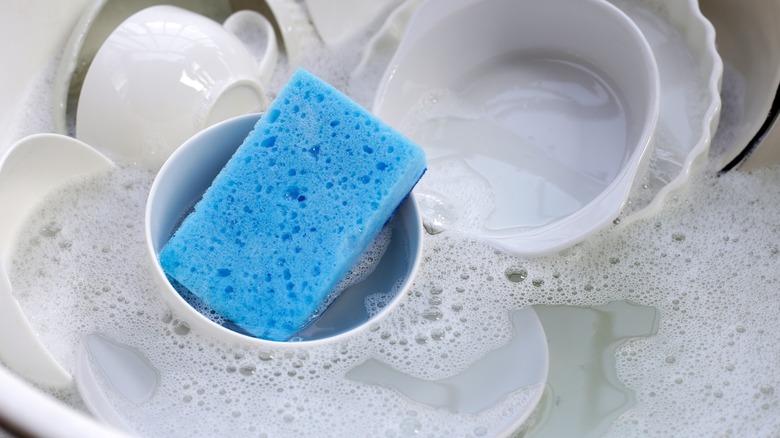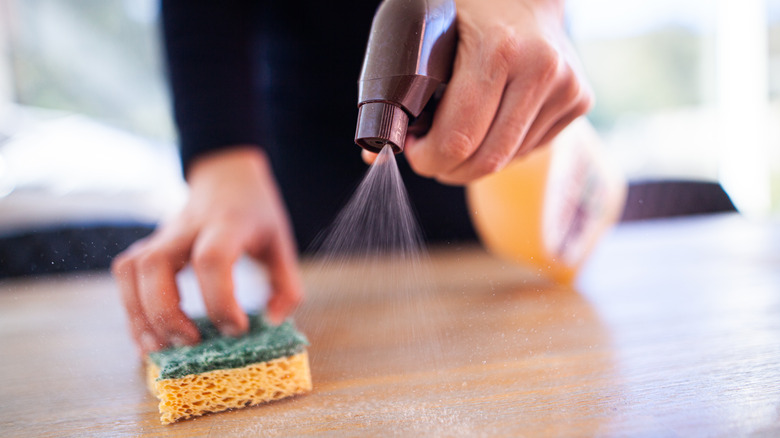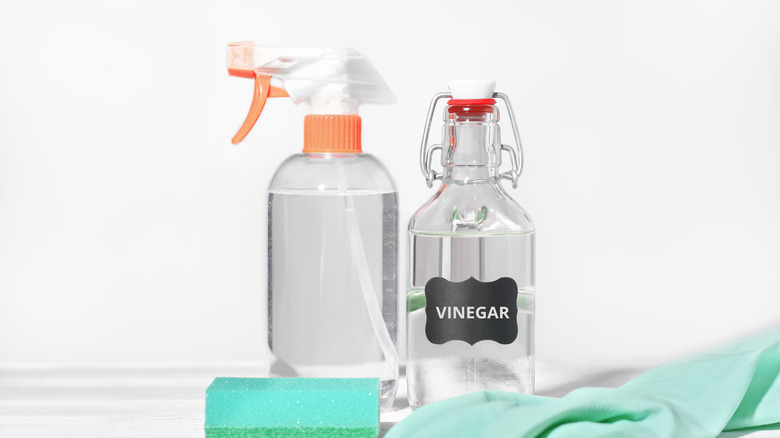Does The Internet's Vinegar Sponge Disinfecting Hack Actually Work?
If you count yourself among the many households that rely on sponges for everyday cleaning, you know how versatile and useful they are. In addition to being ideal for cleaning a wide array of surfaces, sponges are also cheap and easy enough to replace when they are no longer sufficiently serving you. The biggest downside of using sponges for cleaning is the fact that they can be veritable breeding grounds for bacteria, harboring countless strains from salmonella and staphylococcus to E. coli. Without the proper sanitation practices, you could unwittingly be transferring these potent germs onto your stovetop or counters when you complete your closing tasks for the day.
So the question stands: can your sponge be kept sufficiently clean with simple ingredients like vinegar and baking soda? Vinegar has long been touted as a poor man's cleaner and mild disinfectant, and it turns out there is actually some weight behind claims that it can sanitize your sponge. The key is using the right kind of vinegar; instead of relying on 5% acetic acid white distilled vinegar, a thorough sanitization will require the use of the higher-acid cleaning vinegar, which contains 6% acetic acid. In order to clean your sponge, fill a glass bowl with cleaning vinegar and drop the sponge into it, where it will need to sit for about 5 minutes. Once the soaking is done, you can wring it out and use it, knowing that a whopping 99.6% of bacteria have been eliminated.
A word on other all-natural disinfectants
If cleaning vinegar works so well to clean your grubby kitchen sponge, you may be wondering if other all-natural household staples will do the trick. One such proposed ingredient is baking soda, which some claim can disinfect your kitchen sponges effectively. While baking soda is a wonderful resource for certain cleaning tasks, it is certainly not equal to the power of cleaning vinegar. Baking soda, while a fabulously gentle abrasive powder, has no disinfecting power of its own, particularly against the types of bacteria found in sponges. Therefore, while it's great at helping to remove grime from various surfaces in your house, dousing your sponge in a mixture of baking soda and water will not help anything.
Another viable cleaning hack for getting your sponges clean is hydrogen peroxide, which works as a powerful bacteria killer. You'll want to use 3% hydrogen peroxide in order to disinfect your sponge with this method, and will need some patience as this method is slower than the cleaning vinegar. Nevertheless, if you're willing to use a weighted item to hold the sponge submerged in the liquid for 15 minutes (or until it stops bubbling), you'll be rewarded with a fresh cleaning aid. Just rinse and wring dry.
How often should you sanitize your sponges?
While you may be excited about sterilizing your sponges naturally rather than purchasing new ones all the time, it's important to remember that sponges (even sanitized ones) are still harboring bacteria in them. In fact, sanitized sponges may be home to more resistant strains of bacteria, which have evolved to survive in spite of your best attempts to kill them off, according to a 2017 study from Scientific Reports. Keeping your sponges clean is a good idea, but there's a balance to achieve. Even if you're using cleaning vinegar regularly, it is recommended to bring a new sponge into rotation after about a week. If this seems too often, bear in mind that only new sponges are entirely free from bacteria.
When you are sanitizing your sponges with cleaning vinegar, remember to avoid direct contact with your skin, which can cause irritations. Using gloves is always a safe bet, or grab a pair of plastic tongs (avoid using metal tongs, as vinegar can damage the appearance of the metal) to retrieve the sponge from the cleaning solution.


